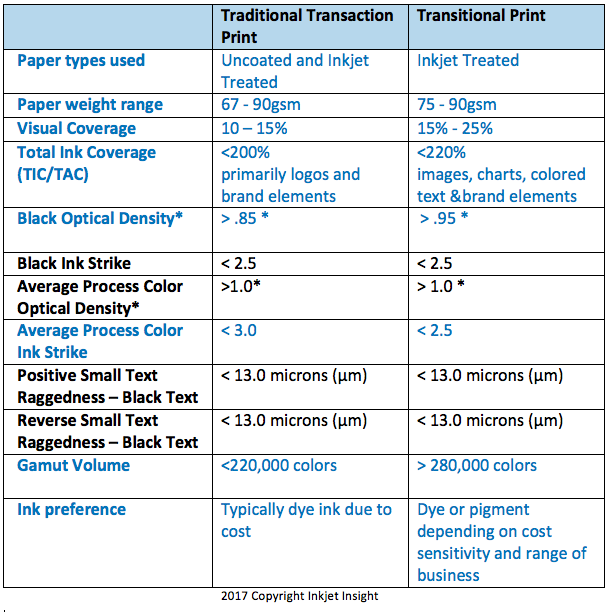Transaction print, transpromo and transitional print are all ways of talking about segments of the production print market that produce statements, invoices, letters, notices and other important customer communications. The term transpromo seems to cause a great deal of fuss and confusion and spin-off terminology like “trans-ed” and “trans-info” pretty much died on the vine.
In the interest of clearing up the confusion, Inkjet Insight prefers to talk about print industry segments in terms of what companies do with their print equipment and the key characteristics of what they produce rather than traditional segmentation focused on marketing. If you look at traditional transaction print before the advent of digital color it was primarily composed of monochrome data and text that was most often imaged onto preprinted stock. Significant volumes were also printed using black toner on plain white paper.
Even as we reach a tipping point where more transaction print volume will be produced on inkjet devices than toner devices, there is still a lot of monochrome transaction print on plain white paper. Many inkjet devices that have color capability use it only for branding and basic forms replacement. This is the segment that we refer to as “Traditional Transaction Print.” Traditional transaction print using inkjet is focused on gaining production efficiencies and postal savings and not on the new capabilities that inkjet production can offer. In highly regulated industries, many companies have limited opportunity to change the look or the content of many of their documents to add value and therefore a focus on efficiency is their best option.
Some transaction printers, and direct mailers who have entered the transaction print space, have had the opportunity to use digital color more ambitiously. These printers are using color, personalization and finishing more dynamically to enhance the value of transaction communications along with improved efficiency. This is the segment that we refer to as “Transitional Print” because it bridges between the traditional role of transaction print and customer-facing direct mail creating some entirely new customer communication opportunities.
We are not creating new terminology for the sake of coining our own terms. We are defining segments based on production requirements and the key performance indicators (KPIs) that measure those requirements. For example, all transaction documents require good text legibility – particularly for the ever present “fine print.” There is also a fairly universal need to manage postal costs by using the lowest basis weight paper while avoiding strike through. However, if only printing monochrome documents on plain or pre-printed stock, there is no need to consider any process color KPIs.
So what is the difference between Traditional Transaction Print and Transitional Print? If you look at the Key Performance Indicators and segment characteristics in the table below, you will see that there are differences in all but a handful of areas. Overall, transitional printing is more quality sensitive, has higher visual coverage, higher ink coverage and, therefore requires finer ink control than traditional transaction print.

For any of these KPIs, performance will be affected by the device itself as well as ink and paper selections.
Note that gamut sensitivity varies, but the differentiation is indicative of the segment as a whole and its level of color sensitivity relative to other types of printing. We find that often the requirement for color accuracy may be specific to a particular brand color. This requirement is sometimes met by a fifth custom color rather than by investing in a broader overall gamut capability.
As noted earlier, paper is a major factor in achieving specific performance thresholds and we will talk more about paper in future posts and with reference to Print Quality Analysis Reports for both traditional and transitional transaction printing segments.
Making transaction print both efficient and effective requires top print and finishing speeds. We will also talk extensively about finishing for transaction printing in future posts.
Since we are in the process of launching our Print Quality Analysis Reporting, we would appreciate feedback on the ways we have segmented the market from a performance standpoint. Do these segments have relevance to your business? Would knowing what device, ink and paper combinations can deliver within these tolerances be valuable. Suggestions for additions or clarifications to segments are very welcome.
We know that there are a lot of new and exciting mail pieces being created in the transaction print world. If you are using inkjet for transitional print and have examples to share, we would appreciate hearing from you.
We also published a list of KPIs for Book Printing which can be found here.
End notes:
* Optical Density (OD) is measured on a logarithmic scale where:
- OD of 0 means that no light is absorbed and 100% of light is transmitted
- OD of 1 means that 90% of light is absorbed and 10% of light is transmitted
- OD of 2 means that 99% of light is absorbed and 1% of light is transmitted
